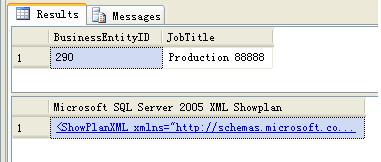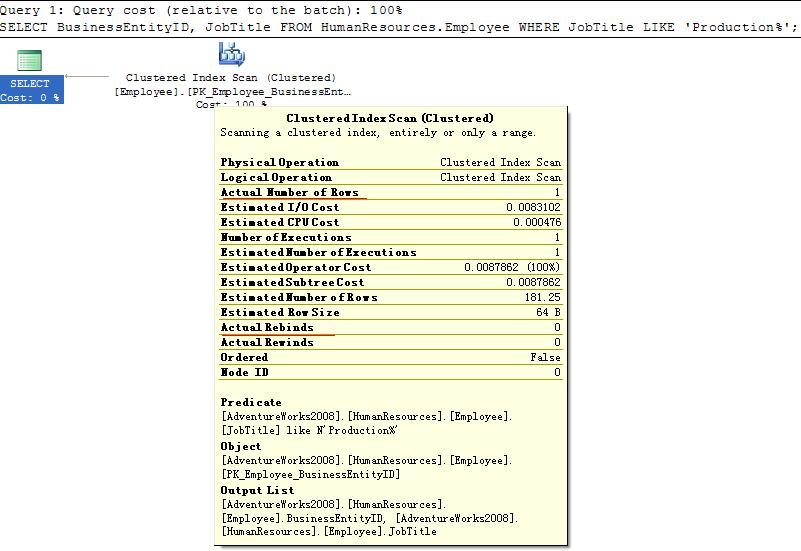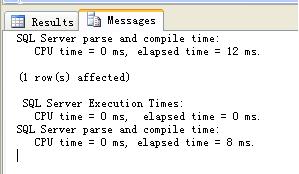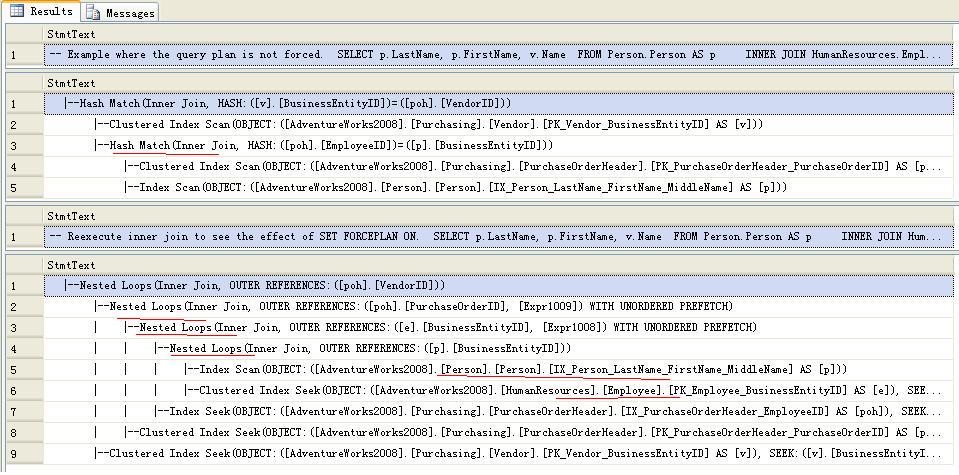SET Statements for SQLServer
SET SHOWPLAN_ALL { ON | OFF }
- It will not execute the TSQL statements.
- It cannot be specified inside a stored procedure,must be the only statements in a batch.
- Returns information as a set of rows that form a hierarchical tree representing the steps taken by the SQL Server query processor as it executes each statement. Each statement reflected in the output contains a single row with the text of the statement, followed by several rows with the details of the execution steps.
SET SHOWPLAN_ALL ON;
GO
SELECT BusinessEntityID, JobTitle
FROM HumanResources.Employee
WHERE JobTitle LIKE 'Production%';
GO
SET SHOWPLAN_ALL OFF;
GO

All the information in the resultset are estimated, no any actual statistics information.
SET SHOWPLAN_XML { ON | OFF }
- It will not execute the TSQL statements.
- It will return detailed information about how the statements are going to be executed in XML.
SET SHOWPLAN_XML ON;
GO
SELECT BusinessEntityID, JobTitle
FROM HumanResources.Employee
WHERE JobTitle LIKE 'Production%';
GO
SET SHOWPLAN_XML OFF;
GO


SET SHOWPLAN_TEXT { ON | OFF }
- It will not execute the TSQL statements.
- It cannot be specified inside a stored procedure,must be the only statements in a batch.
- Returns information as a set of rows that form a hierarchical tree representing the steps taken by the SQL Server query processor as it executes each statement. Each statement reflected in the output contains a single row with the text of the statement, followed by several rows with the details of the execution steps. The table shows the column that the output contains.
- SET SHOWPLAN_TEXT is intended to return readable output for Microsoft Win32 command prompt applications such as the osql utility. SET SHOWPLAN_ALL returns more detailed output intended to be used with programs designed to handle its output.
SET SHOWPLAN_TEXT ON;
GO
SELECT BusinessEntityID, JobTitle
FROM HumanResources.Employee
WHERE JobTitle LIKE 'Production%';
GO
SET SHOWPLAN_TEXT OFF;
GO

SET STATISTICS PROFILE { ON | OFF }
- It will execute the TSQL statements.
- Returns information as a set of rows that form a hierarchical tree representing the steps taken by the SQL Server query processor as it executes each statement. Each statement reflected in the output contains a single row with the text of the statement, followed by several rows with the details of the execution steps.
- While compare with SHOWPLAN_ALL, it has two additional column Rows,Executes.
SET statistics profile ON;
GO
SELECT BusinessEntityID, JobTitle
FROM HumanResources.Employee
WHERE JobTitle LIKE 'Production%';
GO
SET statistics profile OFF;
GO

SET STATISTICS XML { ON | OFF }
- It will execute the TSQL statements.
- It will generate detailed information about how the statements were executed in XML.
- SET STATISTICS XML need not be the only statement in a batch.
- SET STATISTICS XML returns output as nvarchar(max) for applications, such as the sqlcmd utility, where the XML output is subsequently used by other tools to display and process the query plan information. The xml comply with below xsd file \Microsoft SQL Server\100\Tools\Binn\schemas\sqlserver\2004\07\showplan\showplanxml.xsd
- SET STATISTICS PROFILE and SET STATISTICS XML are counterparts of each other. The former produces textual output; the latter produces XML output. In future versions of SQL Server, new query execution plan information will only be displayed through the SET STATISTICS XML statement, not the SET STATISTICS PROFILE statement.
- If Include Actual Execution Plan is selected in SQL Server Management Studio, this SET option does not produce XML Showplan output. Clear the Include Actual Execution Plan button before using this SET option.
SET STATISTICS XML ON;
GO
SELECT BusinessEntityID, JobTitle
FROM HumanResources.Employee
WHERE JobTitle LIKE 'Production%';
GO
SET STATISTICS XML OFF;
GO


SET STATISTICS TIME { ON | OFF }
- When SET STATISTICS TIME is ON, the time statistics for a statement are displayed. When OFF, the time statistics are not displayed.
- The setting of SET STATISTICS TIME is set at execute or run time and not at parse time.
- Microsoft SQL Server is unable to provide accurate statistics in fiber mode, which is activated when you enable the lightweight pooling configuration option.
- The cpu column in the sysprocesses table is only updated when a query executes with SET STATISTICS TIME ON. When SET STATISTICS TIME is OFF, 0 is returned.
- ON and OFF settings also affect the CPU column in the Process Info View for Current Activity in SQL Server Management Studio.
SET STATISTICS TIME ON;
GO
SELECT BusinessEntityID, JobTitle
FROM HumanResources.Employee
WHERE JobTitle LIKE 'Production%';
GO
SET STATISTICS TIME OFF;
GO

SET STATISTICS IO { ON | OFF }
- When STATISTICS IO is ON, statistical information is displayed. When OFF, the information is not displayed.
- After this option is set ON, all subsequent Transact-SQL statements return the statistical information until the option is set to OFF.
- When Transact-SQL statements retrieve LOB columns, some LOB retrieval operations might require traversing the LOB tree multiple times. This may cause SET STATISTICS IO to report higher than expected logical reads.
-
Output item
Meaning
Table
Name of the table.
Scan count
Number of seeks/scans started after reaching the leaf level in any direction to retrieve all the values to construct the final dataset for the output.
-
Scan count is 0 if the index used is a unique index or clustered index on a primary key and you are seeking for only one value. For example WHERE Primary_Key_Column = <value>.
-
Scant count is 1 when you are searching for one value using a non-unique clustered index which is defined on a non-primary key column. This is done to check for duplicate values for the key value that you are searching for. For example WHERE Clustered_Index_Key_Column = <value>.
-
Scan count is N when N is the number of different seek/scan started towards the left or right side at the leaf level after locating a key value using the index key.
logical reads
Number of pages read from the data cache.
physical reads
Number of pages read from disk.
read-ahead reads
Number of pages placed into the cache for the query.
lob logical reads
Number of text, ntext, image, or large value type (varchar(max), nvarchar(max), varbinary(max)) pages read from the data cache.
lob physical reads
Number of text, ntext, image or large value type pages read from disk.
lob read-ahead reads
Number of text, ntext, image or large value type pages placed into the cache for the query.
-
SET STATISTICS IO ON;
GO
SELECT BusinessEntityID, JobTitle
FROM HumanResources.Employee
WHERE JobTitle LIKE 'Production%';
GO
SET STATISTICS IO OFF;
GO

SET FORCEPLAN { ON | OFF }
- When FORCEPLAN is set to ON, the SQL Server query optimizer processes a join in the same order as the tables appear in the FROM clause of a query. In addition, setting FORCEPLAN to ON forces the use of a nested loop join unless other types of joins are required to construct a plan for the query, or they are requested with join hints or query hints.
- SET FORCEPLAN essentially overrides the logic used by the query optimizer to process a Transact-SQL SELECT statement. The data returned by the SELECT statement is the same regardless of this setting. The only difference is the way in which SQL Server processes the tables to satisfy the query.Query optimizer hints can also be used in queries to affect how SQL Server processes the SELECT statement.
USE AdventureWorks2012; GO -- Make sure FORCEPLAN is set to OFF. SET SHOWPLAN_TEXT OFF; GO SET FORCEPLAN OFF; GO SET SHOWPLAN_TEXT ON; GO -- Example where the query plan is not forced. SELECT p.LastName, p.FirstName, v.Name FROM Person.Person AS p INNER JOIN HumanResources.Employee AS e ON e.BusinessEntityID = p.BusinessEntityID INNER JOIN Purchasing.PurchaseOrderHeader AS poh ON e.BusinessEntityID = poh.EmployeeID INNER JOIN Purchasing.Vendor AS v ON poh.VendorID = v.BusinessEntityID; GO -- SET FORCEPLAN to ON. SET SHOWPLAN_TEXT OFF; GO SET FORCEPLAN ON; GO SET SHOWPLAN_TEXT ON; GO -- Reexecute inner join to see the effect of SET FORCEPLAN ON. SELECT p.LastName, p.FirstName, v.Name FROM Person.Person AS p INNER JOIN HumanResources.Employee AS e ON e.BusinessEntityID = p.BusinessEntityID INNER JOIN Purchasing.PurchaseOrderHeader AS poh ON e.BusinessEntityID = poh.EmployeeID INNER JOIN Purchasing.Vendor AS v ON poh.VendorID = v.BusinessEntityID; GO SET SHOWPLAN_TEXT OFF; GO SET FORCEPLAN OFF; GO

DBCC DROPCLEANBUFFERS 清除数据缓存
DBCC FREEPROCCACHE 清除执行计划缓存
REFERENCES
SET SHOWPLAN_XML
http://technet.microsoft.com/en-us/library/ms187757.aspx
SET SHOWPLAN_TEXT
http://technet.microsoft.com/en-us/library/ms176058.aspx
SET SHOWPLAN_ALL
http://technet.microsoft.com/en-us/library/ms187735.aspx
SET STATISTICS PROFILE
http://technet.microsoft.com/en-us/library/ms188752.aspx
SET STATISTICS XML
http://technet.microsoft.com/en-us/library/ms176107.aspx


